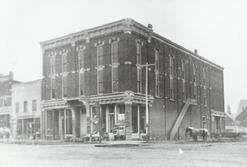Howell Opera House
The Howell Opera House is an opera house located in Howell, Michigan. The site is listed as historic by The Michigan State Historic Preservation Office.[2] It is also listed on The National Historic Register[3] as part of the Howell Downtown Historic District.
| Howell Opera House | |
|---|---|
 Howell Opera House in 1881 | |
| Location | Michigan |
| Coordinates | 42°36′26″N 83°55′49″W |
| Designated | February 11, 1972[1] |
| Reference no. | P23969 |
 Location of Howell Opera House in Michigan | |
History
The Howell Opera House is a Victorian-style building with a seating capacity of 1,000 people.[4] Plans for the theater were drawn and executed by Detroit architect, Almon C. Varney at the cost of $10,000. Construction began in 1880 by Hunter and Holmes Contractors and doors were opened to patrons on December 30, 1881.[5] The building is located at 123 W. Grand River.
As the central part of the town, the edifice served not only for artistic performances but as a venue for several local occasions such as high school commencement. The theater also served, for a short duration, as home to the Livingston County Circuit Court in 1889.[4]
The Howell Opera House was first owned by the Stair Brothers, E.D. and Orin, who assumed ownership in 1884. The theater was later purchased by Arthur Garland in 1893 [5] who utilized a portion of the space to produce custom-tailored suits.
In 1923, the building was closed by the fire marshal.[4] This brought an end to its intended use as quarters for entertainment. For more than 70 years, The Howell Opera House served as storage for a local hardware store.
Renovation
In 2000, The Livingston Arts Council purchased The Howell Opera House [4] with plans to restore the patronage to function, once again, as a theater. Renovations began in 2001 with a slow start due to lack of funding. In 2007, the first installment of the development plan had been completed.[6]
Renovations were made solely to the first floor. These renovations include refinished flooring and walls as well as new stairways.[7] Plans have also been made for restoration of the second floor which houses the stage and balcony.
The renovated first floor of the Opera House is now available to rent for special events such as weddings and parties.[8]
References
- "Michigan's Historic Sites Online". Michigan State Housing Development Authority. Archived from the original on March 22, 2013. Retrieved March 23, 2013.
- Archived 2012-06-12 at the Wayback Machine State of Michigan. State Historic Preservation Office. Opera House. Michigan State Historic Preservation Office, 2010. Web. 9 Oct. 2011.
- United States. Dept. of the Interior. National Register of Historic Places. US Dept. of the Interior, 2010. Web. 9 Oct. 2011.
- “The Opera House: Past and Present.” The Opera House. Livingston Arts Council, 2010. Web. 21 Sept. 2011
- Gray, D.J. “The Opera House.” The Howell Bicentennial History. Michigan: Howell, 1975. 178-84. Print.
- “Livingston Arts Council: Howell Opera House.” Christman. The Christman Company, 2007. Web. 5 Oct. 2011.
- Behnan, Christopher. “Restoration, Popularity of Opera House Still Growing.” Daily Press and Argus. Daily Press and Argus, 2 Sept. 2011. Web. 11 Oct. 2011.
- http://www.howelloperahouse.com/rental-information/